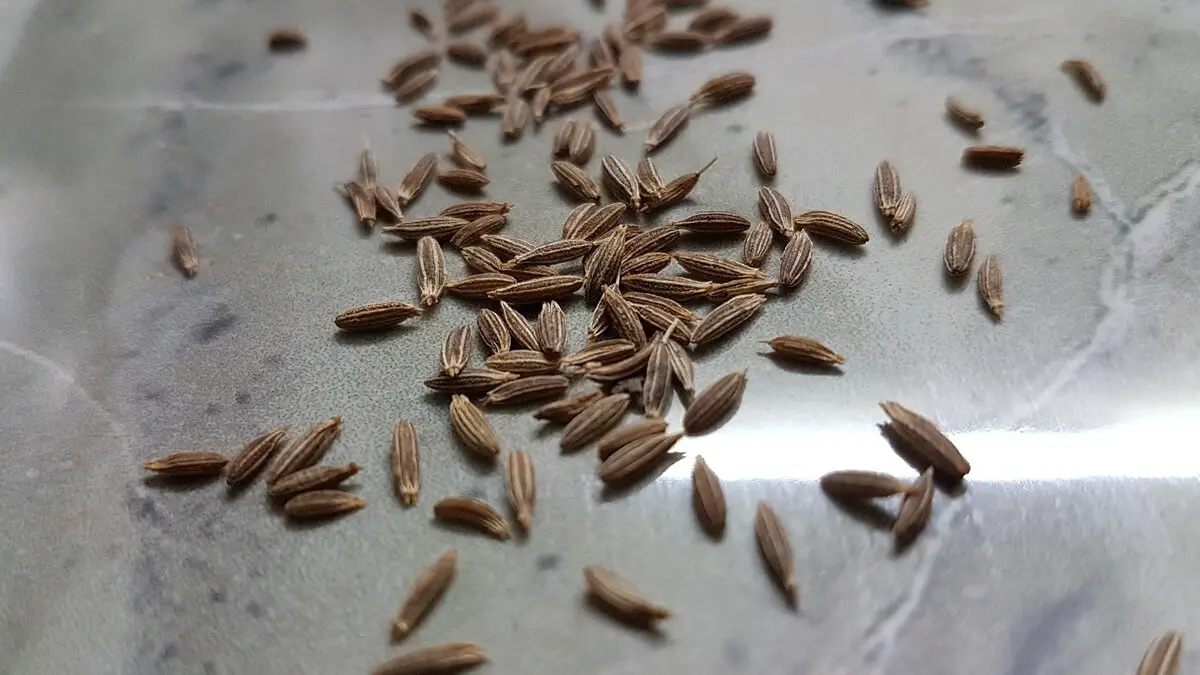Growing Cumin in Garden
Cumin (Cuminum cyminum) also has other names such as Geerah and seeragam. It belongs to Apiaceae (flowering plant) family. Cumin is native to the lands from the middle east to India, including some parts of western China. Growing cumin is common in these regions.
This article focuses on growing cumin in gardens, caring, its characteristics, and uses.
Generally, growing cumin is comparatively easy and beneficial. The fruits contain seeds(cumin) within them. Growers dry these fruits to separate out the cumin seeds. Many cuisines all over the world use these seeds as their main ingredient. You can use them in ground form or whole form.
These seeds also serve humans in traditional medicines. However, there is no evidence that they are safe or as effective as modern therapeutic agents.
The Latin word ”Cuminum” is the source of derivation for the word ”cumin”. This Latin word in turn is derived from Ancient Greek “kúminon”, in relation to Hebrew (kammōn) and Arabic words (kammun). Ultimately, the Akkadian language word “kamūnu” is the source of all these derivations.
Table of Contents
Growing Cumin – History
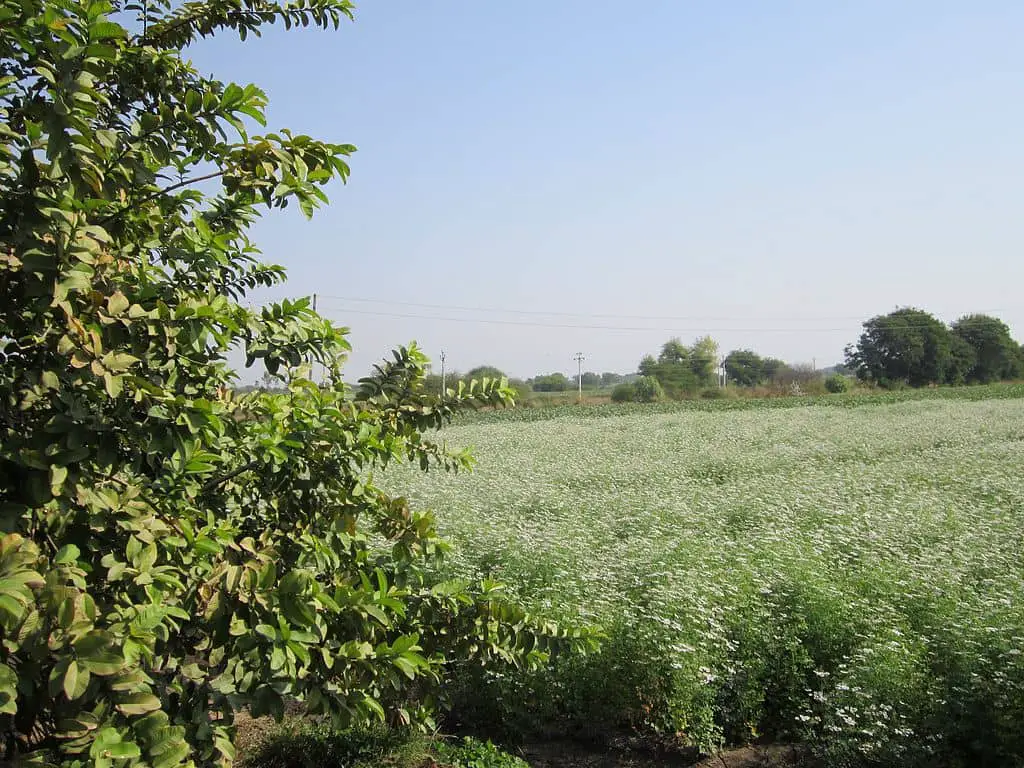
Photo by Raj Odedra (Wikimedia Commons) (CC BY 3.0)
Syrians were growing cumin for thousands of years. They have cultural evidence for this statement. Some of their excavated seeds date back to the second millennium BC. Archaeologists found several cumin seeds from ancient Egyptian locations. In Fact, ancient Egyptians used cumin seeds as a spice int heir foods. They also used these seeds as preservatives in the drying process (mummification) of dead bodies.
The Minoans of ancient Crete islands used cumin as a food spice. Their “Linear A” archive tablets have documented cumin Ideograms.
Generally, some of us keep pepper in a separate tiny jar at our dining tables. Similarly, ancient Greeks kept cumin seeds in separate tiny jars on their dining tables. The Moroccans also followed the same practice.
Also, the Ancient Romans used cumin as a spice in their famous cuisines. Traditional recipes of Southeast Asia, including India and China, include cumin as the main ingredient. Cumin also caters as the basis for many famous spice blends all over the world.
Portugal and Spanish colonists introduced cumin to Americans. Persians use Black and green cumin in their cuisines. Southeast Asian and Northern African countries are growing cumin from ancient times as these plants are native to them. Even today, you can find them growing cumin commercially and exporting all over the world.
In fact, cumin is an introduced species in parts of the world. Due to benefits, people all over the world prefer growing cumin.
Description
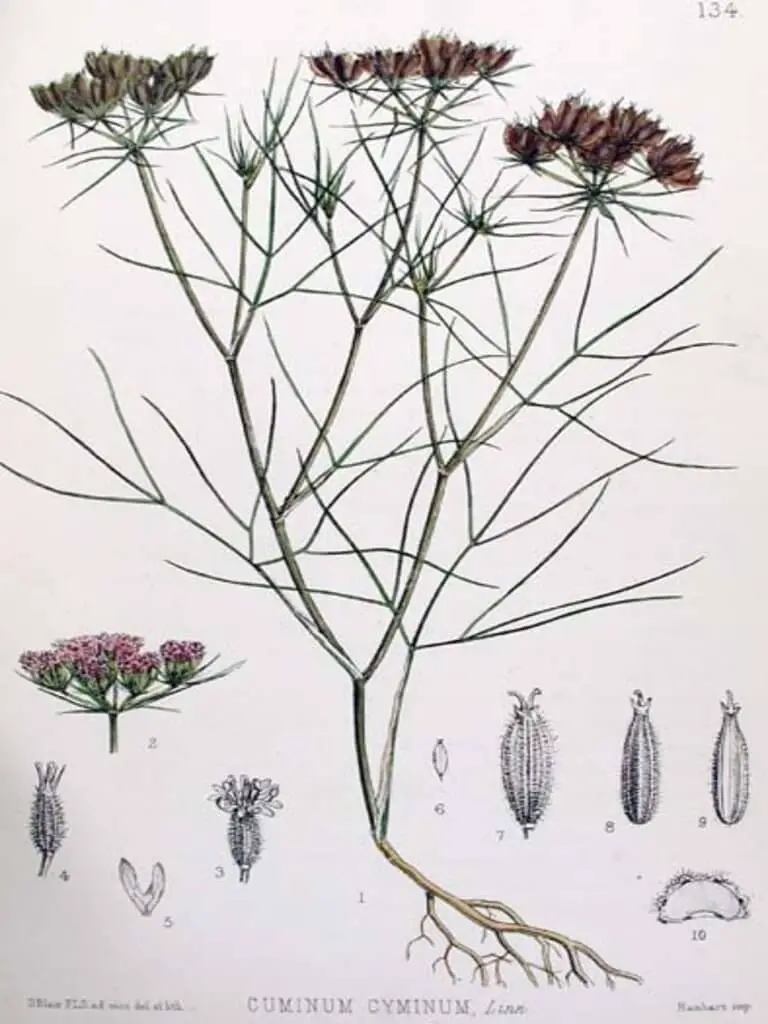
Cumin plant is an herbaceous plant. Normally, this summer annual plant grows 12–20 inches (30–50 cm) tall. You can harvest it by bare hands easily. The diameter of its glabrous, slender stems is about 1–2 in (3–5 cm).
Each branch sprouts 2-3 subbranches that grow uniformly tall. Hence, they form an almost flat canopy. These stems are usually dark green or grey in color.

Photo by JonRichfield (Wikimedia Commons) (CC BY-SA 4.0)
The (2 – 4 in) 5 – 10 cm long leaves develop in pinnate or bipinnate fashion. Similarly, the small pink or white flowers sprout out in umbels. Usually, every Individual umbel consists of 5-7 umbellets.
The fruit is 4-5 mm long. It has seeds contained within. These seeds resemble Persian cumin (caraway) seeds in appearance.
Growing Cumin – Propagation

Photo by Herbolario Allium (Wikimedia Commons) (CC BY 2.0)
Generally, Cumin is a hot climate crop as it is native to the Mediterranean region. So, you cannot expect it to tolerate hard frosts. It needs a long warm season to grow healthy. Cummins can adapt to USDA Zones 5-10. Methods for growing cumin from seeds are listed below.
Cold Areas
Growing cumin in colder areas is feasible. First, start from sowing seeds indoors in containers. Then, transplant them outdoors after germination, when the temperature exceeds at least 60-degree Fahrenheit.
Generally, these plants do not transplant well and are vulnerable to transplant shocks. So, it is advisable to use biodegradable pots to sow the seeds. you can directly “bury” these biodegradable containers in the garden while transplanting.
Start the process 1-2 months prior to the last frost date. Soak the seeds in Luke warm water for about 8-12 hours. This increases germination rates. Then, sow the seeds indoors in biodegradable pots. You can expect germination in about a couple of weeks.
Alternatively, you can use homemade soil blocks to sow the seeds. You can prepare these blocks by compressing the soil mixed with the potting mixture in a block maker. This method also helps eliminate the use of plastic pots and the risk of transplant shocks.
Start by sowing seeds at least 1/4 inch deep. Maintain the soil moisture by misting daily until the fresh growth appears. You can expect this to happen with a few weeks.
In either of the above methods, you can expect the cumin plant to grow 1-2 inches tall in about a couple of months. After that, When the outdoor temperature exceeds 60-degree Fahrenheit, transplant the fresh cumin plant in the garden.
Warm Areas
If you live in warm areas that enjoy frost-free weather for at least 4-5 months, you can prefer this method. However, this method works best in areas where the night temperatures do not fall below 60-degree Fahrenheit during warmer climates.
This method also helps in avoiding transplant shock threats.
Start the process 1-2 weeks after the last frost date. Select a location that gets full sunlight. Sow the seeds at least 1/4 inch deep, 4-8 inched apart. If you plant them in rows, make sure the distance between them is at least 18 inches.
Alternatively, you can plant the seeds in clumps (not rows). In this method, the spindling plants grow together while supporting each other.
Maintain the soil moisture for a couple of weeks after sowing the seeds. You can expect germination at this time.
Each plant produces only a few seeds. So, if your intention is to gather seeds, then growing cumin in larger areas is advisable.
Growing Cumin – Caring
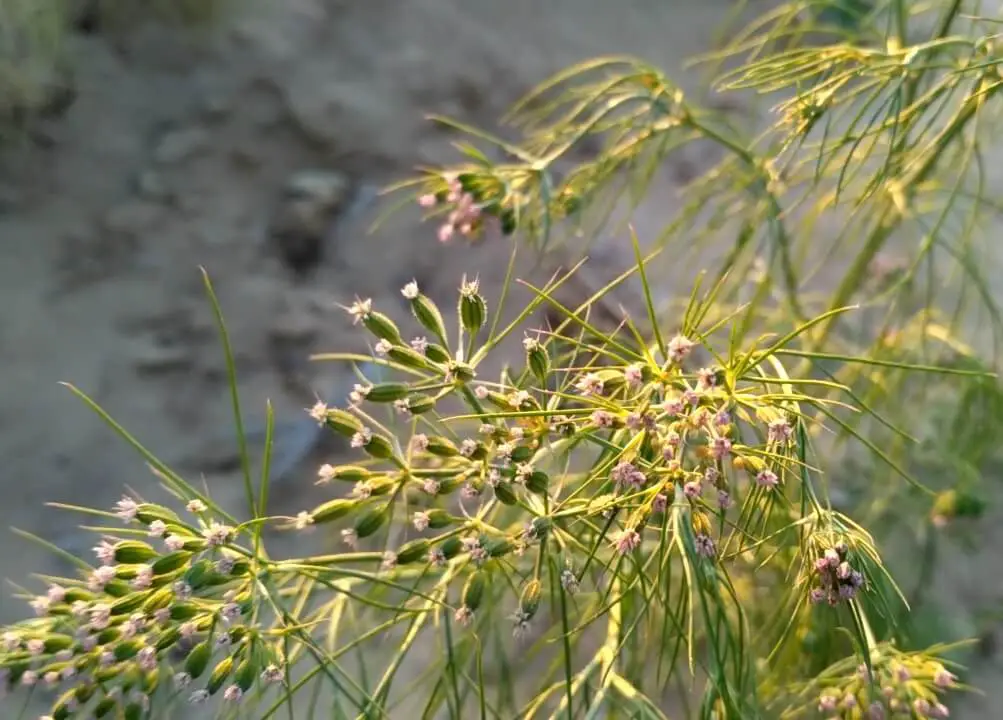
Photo by WikiPanti (Wikimedia Commons) (CC BY-SA 4.0)
Generally, cumin requires at least 4 warm months to mature and develop seeds. Hence, growing cumin in warmer areas is preferable.
Cumin prefers to grow in sunlight and sandy loam soil that drains well. It can also tolerate most of the nutrient-rich soils. The ideal soil PH value for growing cumin is 7.0 -7.5
Once the plant establishes itself, maintenance is not a matter of concern. Water reasonably during long dry and hot periods. Do not wait until the soil dries out completely.
These plants can tolerate drought to some extent. Avoid overwatering of plants. Waterlogging can cause root rots, which can ruin the plant as a whole. As a precaution, it is advisable to mist the plants regularly during hot months.
Cover the plant surroundings with good quality mulch. It can help to retain soil moisture. It prevents the soil from drying out completely or being waterlogged.
Confusion with Other Species

Photo by Sanjay Acharya (Wikimedia Commons) (CC BY-SA 3.0)
Most people confuse Cumin with caraway (Persian cumin). Persian cumin is another specie from the same Apiaceae family.
Generally, Cumin is larger in size (about 5mm), lighter in color, and tastes a bit hotter. Caraway has dark olive color and shorter in length (about 2mm). It tastes peppery and earthy with a hint of citrus.
Some European languages do not differentiate between the two varieties clearly. Many Uralic and Slavic languages refer to cumin as “Roman caraway”.
Both Bunium bulbocastanum and Bunium persicum are distantly related to cumin. Nigella sativa has no relation with cumin. Still, most people call all three of them as black cumin.
Growing Cumins – Diseases and Pests Management
Growing cumin has the merit of attracting beneficial insects to your garden.
These plants attract ladybugs, lacewings, predatory wasps, and other beneficial insects that munch caterpillars and insects. In addition, these beneficial insects prey on harmful insects in other plants too. Thus, these plants can protect the entire garden, including the surrounding areas.
Thus, this plant saves itself and also the other plants from hungry luring insects
Pests
In spite of their beneficial characteristics, these plants are a bit vulnerable to some fungal diseases and pests.
Aphids
Aphids are tiny pests. They stick on to the foliage of plants. These insects usually eat through foliage and cause holes. They also suck out the sap through the holes. Mostly, they damage fresh growing and younger parts of the plants.
If the plants get aphids infection, they start showing signs. Some of those signs include curling leaves, Stunted growth, and foliage turning yellow.
Aphids secrete “honeydew”, a sticky semi-liquid. This liquid in turn causes another infection called sooty mold.
You can remove Aphids by applying pressured water from hosts. Do this in summer mornings. This gives plants more time to dry out with the help of a warm climate during the day time. In the case of closely growing plants, this method becomes more preferable.
Alternatively, you can use good quality insecticidal soap to treat aphids.
It is always preferable to have a handy guide to treat aphids and other pests in the garden.
Diseases
Alternaria Blight
Alternaria blight is a common fungus infesting plants during hot and humid conditions. During the flowering stages, this fungus prevents the seeds from maturing fully. This results in shriveling up and blowing away of seeds from pods.
Using a good quality weeding machine, remove the weeds surrounding plants regularly. Avoid overwatering plants. By following these practices, you can prevent Alternaria Blight.
Powdery Mildew
Powdery mildew is a fungus that develops commonly on the foliage of plants. It forms a white coating on foliage. This fungus hinders seed formation. it also causes decolorization or Stunted growth of seeds.
If you find this infection, remove and dispose off the foliage as immediately as possible.
You can also use neem oil or good quality fungicide to treat powdery mildew.
Fusarium Wilt
This is one of the common fungal diseases that affect plants. This causes discoloration and wilting of foliage.
This fungus lives in soil and seeds. It also has the ability to spread through wind and water.
Harvest the ripen seeds as immediately as possible. This helps to reduce the risk of fusarium wilt infection in seeds.
Growing Cumin – Harvesting
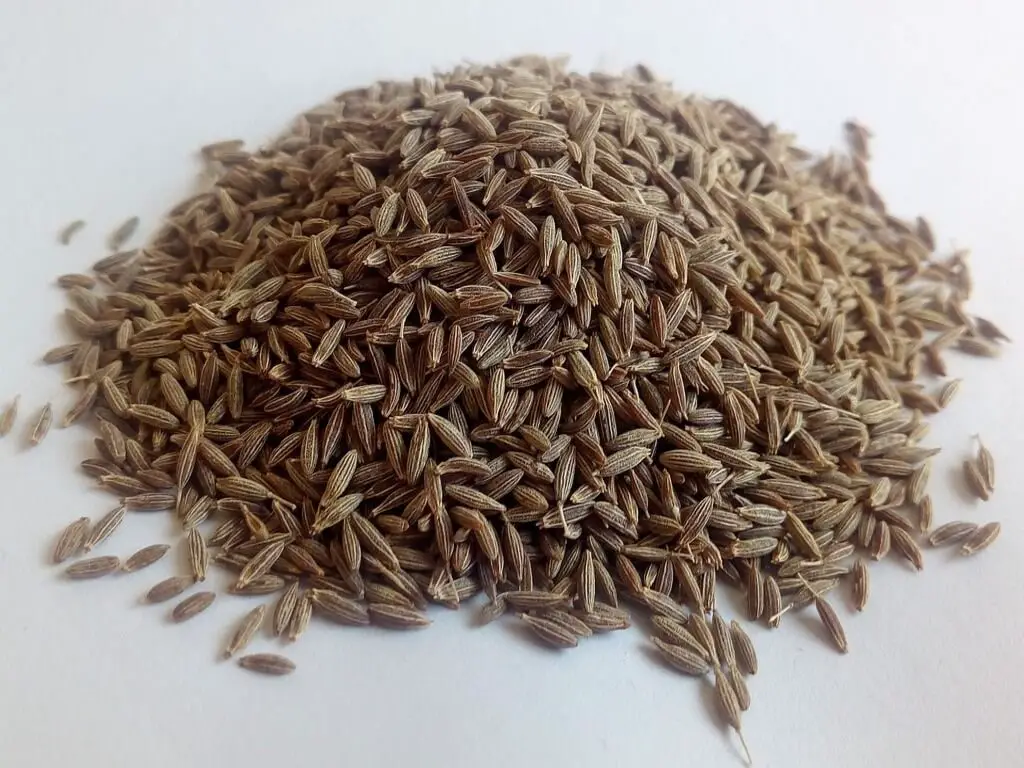
Growing cumin on your own and harvesting is a matter of joy and celebration!
Generally, the cumin plants produce seeds in about 4 months after planting. But this period can vary from 3 months to 5 months depending on the environment. So, always keep a watch on plants throughout the harvesting season. If you delay harvesting, the seeds may dry out and fall away.
Normally, all the cumin plants do not ripen at the same time. So, you may have to collect the seeds little by little every day.
Generally, during the fall, the flowers finish blooming. Followingly, the clusters turn brownish in color, thereby drying out completely.
This is the right time to harvest. Cut the stems containing clusters as a whole, close to the ground. Place the stems in paper bags. Tie the bottom portion of the stems together. Hang them upside down in a dark, warm, and dry place.
In a weeks’ time, the seeds will completely dry out. After that, rub the seed pods in between your thumb and index finger. Collect the dropping seeds.
Alternatively, you can also thresh the stems in the bag against a wall or any other hard surface. This removes the seeds from the pods. Collect the seeds and remove the debris out.
Store the collected cumin in airtight jars. Place the jars in dark, dry, and cool space. You can use the stored seeds for up to 2 years. You also have the option of replanting the seeds in the garden during the next season.
Uses of Growing Cumin
Generally, you can use cumin as whole seeds or ground ones. It adds a warm, earthy, and aromatic character to the cuisines and other foods. Cumin is also used as an ingredient in pastries and pickles.
You can find cumin most widely used in some cheese types, especially Leyden cheese. It serves as the main ingredient in traditional bread in France. Mexican style chili powder is flavored with cumin. Garam masalas, achiote blends, sofrito, bahaarat, adobos, and many other mixtures have cumin powder as their main ingredient.
Many south Asian dishes have cumin powder mixed with coriander leaves as flavoring agents.
Traditional uses
Several countries around the world use cumin in their traditional medicine. They usually powder the seeds and use them as vati (tablet/pills), kashaya (decoction), or arishta (fermented decoction), especially in india.
Generally, in south India and Srilanka, people use to boil cumin with water. They call it “Jira water”. They also believe this Jira water can prevent or cure a common cold, mild digestive problems, etc.
However, there is no established scientific evidence to prove the above theories.
Essential oils
Cumin oil has terpenoids, Cuminaldehyde, and cymene as the major volatile components. Hence, industries use cumin oil to produce perfumes, a variety of flavors, and other essential oils. Some manufacturers use cumin to produce various cosmetics.
Medicinal Benefits
Digestion
The traditional usage of cumin is to cure indigestion. In fact, modern studies indicate cumin can speed up the normal digestion process.
Rich Iron source
Naturally, the Jira (cumin) seeds have rich iron content.
Beneficial Substances
Jira seeds have numerous plant compounds that are beneficial to humans. Those include alkaloids, phenols, terpenes, and flavonoids.
Diabetes Treatment
Modern studies indicate Jira seed components counter some long-term effects linked with diabetes.
Blood Cholesterol Improvement
Modern clinical studies confirm that Jira seeds components can improve Blood Cholesterol
In addition, the cumin is useful in preventing Food-Borne Illnesses, treating Narcotic dependence, fighting Inflammation, promoting weight loss & fat reduction
You can add a small amount of cumin in your food. But if you want to take cumin in as a supplement, consult a certified physician.
Other Facts
Aroma Profile
Cumin’s essential oil content and primary aroma compound are Cuminaldehyde . This compound is responsible for cumin’s warm aroma and distinctive flavor.
Toasted cumin also has other aroma compounds such as 2-methoxy-3-sec-butylpyrazine, 2-methoxy-3-methylpyrazine, and -ethoxy-3-isopropylpyrazine.
In addition, these seeds have other important compounds such as safranal, β-pinene, p-cymene, and γ-terpinene.
Nutritional Value
In general, the cumin seeds have a large amount of the Daily Value for protein, fat (particularly monounsaturated fat), and dietary fiber (table).
Also, these seeds contain considerable DV amounts of vitamin E, B vitamins, magnesium, manganese, and protein. They also contain petroselinic acid.
Final Thoughts
You can consider cumin for cooking almost any type of food on earth. Just add a dash of these aromatic seeds, and the job is done! its flavor enhances the dining experience to an entirely new level.
Boil water with these seeds, it turns water into a therapeutic liquid, at least as believed by traditionalists.
In addition, you can use them for attracting beneficial insects, thereby making your garden almost pest-free! What a natural preservative indeed!
Growing cumin is useful in many ways. Just try once, you will be happy by doing so!
Similar posts
Growing Chicory Plants in Gardens
Growing Acorn Squash in Gardens

